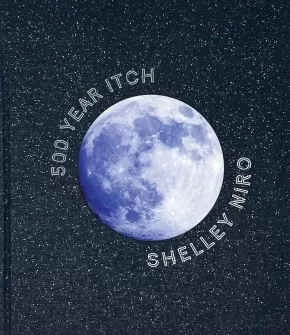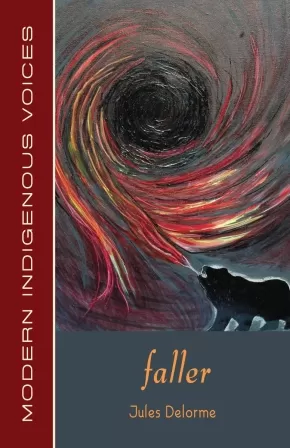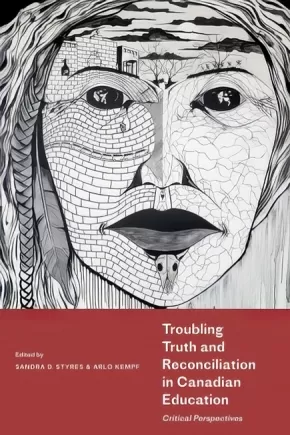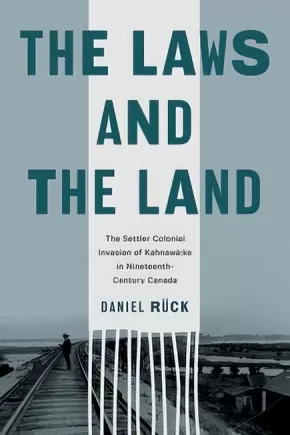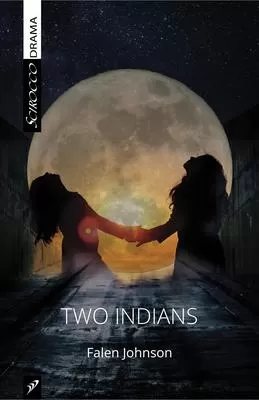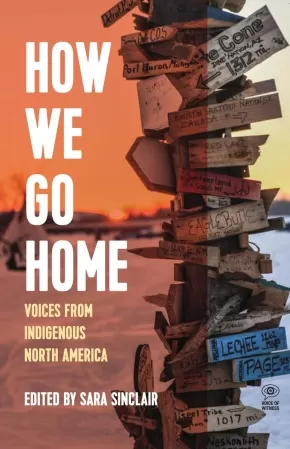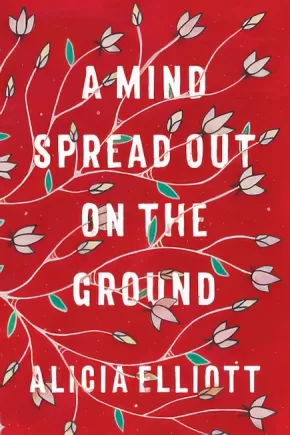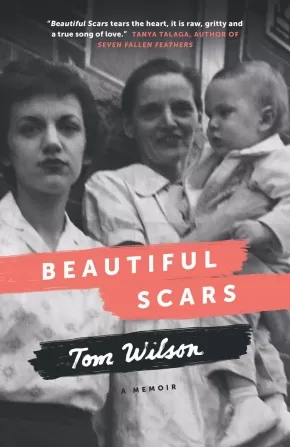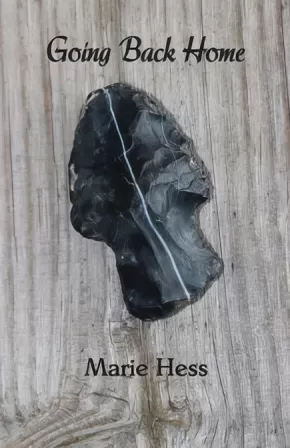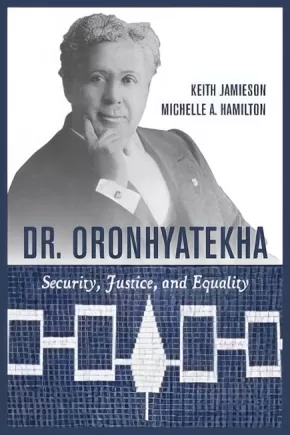
Kanyen’kehà:ka (Mohawk)
16
-
30
of
32 Results;
Sort By
Go To
of 3
Shelley Niro: 500 Year Itch
$50.00
Format:
Hardcover
Text Content Territories:
Indigenous Canadian; First Nations; Haudenosaunee (Iroquois); Kanyen'keha:ka (Mohawk);
Reading Level: N/A
ISBN / Barcode: 9781897407356
Synopsis:
Synopsis:
Shelley Niro is widely known for her ability to explore Traditional Stories, transgress boundaries, and embody the ethos of her matriarchal culture. A member of the Kanyen’kehaka (Mohawk) Nation, she uses a wide variety of media, including photography, installation, film, and painting to bring greater visibility to Indigenous women and girls.
Pushing the limits of photography, Niro incorporates imagery from Traditional Stories to focus on contemporary subjects with wit, irony, and parody. Throughout her work — in her portraiture, sculptures, landscape paintings, photography, and film and video work — Niro challenges common preconceptions about gender, culture, and Indigenous Peoples.
Shelley Niro: 500 Year Itch brings together 215 reproductions from Niro’s expansive oeuvre, including work published here for the first time. Also included in this career retrospective are three major essays about Niro’s work by Melissa Bennett, Greg Hill, and David W. Penney, as well as texts from seven guest artists, scholars, and curators. Shelley Niro: 500 Year Itch accompanies an international touring exhibition organized by the Art Gallery of Hamilton and the Smithsonian National Museum of the American Indian with the collaboration of the National Gallery of Canada.
Additional Information
304 pages | 8.25" x 9.62"
Faller
$19.95
Format:
Paperback
Text Content Territories:
Indigenous Canadian;
Reading Level: N/A
ISBN / Barcode: 9781772311747
Synopsis:
Synopsis:
Faller mixes Roshoman style storytelling with traditional stories to describe the meeting, or juxtapositions, of a few characters on a Reservation. All of these characters are damaged in one way or the other. Faller is not narrative so much as bursts and flashes. It is not about what happens as much as moments in time. The stories fall together rather than follow each other. Faller is dark and funny in places, less sane and rational than yearning. Haunted. Not like every other book, Faller is the first work by an old young Indigenous writer, not trying to make sense of life on the Reservation, but giving a glimpse into the world he grew up in.
Educator & Series Information
This book is part of the Modern Indigenous Voices series.
Additional Information
80 pages | 8.50" x 5.50" | Paperback
Troubling Truth and Reconciliation in Canadian Education: Critical Perspectives (Styres-Kempf-Hare)
$46.99
Format:
Paperback
Text Content Territories:
Indigenous Canadian;
ISBN / Barcode: 9781772126006
Synopsis:
Synopsis:
Troubling Truth and Reconciliation in Canadian Education offers a series of critical perspectives concerning reconciliation and reconciliatory efforts between Canadian and Indigenous peoples. Indigenous and non-Indigenous scholars address both theoretical and practical aspects of troubling reconciliation in education across various contexts with significant diversity of thought, approach, and socio-political location. Throughout, the work challenges mainstream reconciliation discourses. This timely, unflinching analysis will be invaluable to scholars and students of Indigenous studies, sociology, and education.
Contributors: Daniela Bascuñán, Jennifer Brant, Liza Brechbill, Shawna Carroll, Frank Deer, George J. Sefa Dei (Nana Adusei Sefa Tweneboah), Lucy El-Sherif, Rachel yacaaʔał George, Celia Haig-Brown, Arlo Kempf, Jeannie Kerr, Ruth Green, David Newhouse, Amy Parent, Michelle Pidgeon, Robin Quantick, Jean-Paul Restoule, Toby Rollo, Mark Sinke, Sandra D. Styres, Lynne Wiltse, Dawn Zinga
Reviews
"This is crucially important work at this time, as universities, provincial education boards, and school districts grapple with their responses to the TRC. The contributors to Troubling Truth and Reconciliation in Canadian Education continue dialogues around reconciliation, decolonization, and Indigenization in schools at every level across Canada and offer real and actionable insights for educational leaders and teachers." - Shannon C. Leddy, University of British Columbia
"Troubling Truth and Reconciliation in Canadian Education is a significant contribution in this era of the post-TRC, the Calls to Action, the MMIWG inquiry report, and the ongoing difficulties and legacies of systemic racism/colonialism against Indigenous peoples in Canadian institutions." - Lisa Korteweg, Lakehead University
Educator Information
Table of Contents
vii Foreword
JAN HARE
xiii Acknowledgements
xv A Troubling Place to Start: Reconciliation in Collapse
ARLO KEMPF, SANDRA D. STYRES, LIZA BRECHBILL AND LUCY EL-SHERIF
I
Theoretical Perspectives on (Ir)reconciliation: Polishing the Silver Covenant Chain
1 | Discovering Truth in the Post-TRC Era: Morality and Spirituality Discourses in the Reconciliatory Journeys of Schools
FRANK DEER
2 | Indigenous Resiliency, Renewal, and Resurgence in Decolonizing Canadian Higher Education
MICHELLE PIDGEON
3 | Uncomfortable Realities: Reconciliation in Higher Education
DAWN ZINGA
4 | Contested Knowledges: Indigeneity, Resistance, and Black Theorizing in Academia
GEORGE J. SEFA DEI (NANA ADUSEI SEFA TWENEBOAH)
5 | Some of Us Are More Canadian Than Others: Pedagogies of Citizenship and Learning Racialized Settlerhood
LUCY EL-SHERIF AND MARK SINKE
6 | The Performativity of Reconciliation: Illusory Justice and the Site C Dam
RACHEL YACAAʔAŁ GEORGE
7 | Beyond Curricula: Colonial Pedagogies in Public Schooling
TOBY ROLLO
II
Reconceptualizing Reconciliation in Education: Teaching and Learning in Right Relation
8 | Reconciliation and Relational Ethics in Education
SANDRA D. STYRES AND ARLO KEMPF
9 | Exploring Tensions in Taking Up the Call for Reconciliation in Teacher Education
LYNNE WILTSE
10 | Troubling Trespass: Moving Settler Teachers Toward Decolonization
DANIELA BASCUÑÁN, MARK SINKE, SHAWNA M. CARROLL, AND JEAN-PAUL RESTOULE
11 | Talking It Through, Talking Through It: A Dialogue on Indigenizing Education
CELIA HAIG-BROWN AND RUTH GREEN
12 | Recalling the Spirit and Intent of Indigenous Literatures
JENNIFER BRANT
13 | Teaching Indigenous Studies in a Time of Reconciliation: An Anticolonial Approach Toward Postcolonial Awareness
DAVID NEWHOUSE AND ROBIN QUANTICK
14 | Contemporary Colonialism and Reconciliation in Higher Education: A Decolonial Response Through Relationality
JEANNIE KERR AND AMY PARENT
Contributors
Additional Information
328 pages | 6.00" x 9.00" | Paperback
The Laws and the Land: The Settler Colonial Invasion of Kahnawà:ke in Nineteenth-Century Canada
$39.95
Format:
Hardcover
Text Content Territories:
Indigenous Canadian; First Nations; Haudenosaunee (Iroquois); Kanyen'keha:ka (Mohawk);
Grade Levels: University/College;
ISBN / Barcode: 9780774867436
Synopsis:
Synopsis:
As the settler state of Canada expanded into Indigenous lands, settlers dispossessed Indigenous people and undermined their sovereignty as nations. One site of invasion was Kahnawà:ke, a Kanien’kehá:ka community and part of the Rotinonhsiónni confederacy.
The Laws and the Land delineates the establishment of a settler-colonial relationship from early contact ways of sharing land; land practices under Kahnawà:ke law; the establishment of modern Kahnawà:ke in the context of French imperial claims; intensifying colonial invasions under British rule; and ultimately the Canadian invasion in the guise of the Indian Act, private property, and coercive pressure to assimilate. Daniel Rück reveals increasingly powerful and aggressive colonial governments interfering with the affairs of one of the most populous and influential Indigenous communities in nineteenth-century Canada. What he describes is an invasion spearheaded by bureaucrats, Indian agents, politicians, surveyors, and entrepreneurs. Although these invasions were often chaotic and poorly planned, Rück shows that despite their apparent weaknesses they tended to benefit settlers while becoming sources of oppression for Indigenous peoples who attempted to navigate colonial realities while defending and building their own nations.
This original, meticulously researched book is deeply connected to larger issues of human relations with environments, communal and individual ways of relating to land, legal pluralism, historical racism and inequality, and Indigenous resurgence. It is one story of the "slow violence" of Canada’s legal and environmental conquest of Indigenous peoples and lands, and the persistence of one Indigenous nation in the face of the onslaught.
This book will appeal to legal historians, historical geographers, and scholars of Quebec history, Canadian history, and Indigenous studies.
Reviews
"In this excellent book, Daniel Rück has woven a seamless web of law, history, geography, and Indigenous knowledge, and has made it all look easy." — Philip Girard, professor, Osgoode Hall Law School, York University
"The Laws and the Land is an account of colonial harm. It is an unprecedented look at the dispossession and oppression of the People of Kahnawà:ke by slowly taking their lands away. This book is a must-read for our People but also for all Indigenous peoples who have been dispossessed by the settler governments, churches, and unscrupulous individuals. And it also shows the perseverance and survival of a Mohawk community." — Kenneth Deer, former secretary of the Mohawk Nation at Kahnawà:ke and honorary doctor of laws, Concordia University
Educator Information
Table of Contents
Introduction
1 Kahnawà:ke and Canada: Relationships of Laws and Lands
2 "Whereas the Seigniory of Sault St. Louis Is the Property of the Iroquois Nation": Dissidents, Property, and Power, 1790–1815
3 "Out of the beaten track": Before the Railroad, 1815–50
4 "In What Legal Anarchy Will Questions of Property Soon Find Themselves": The Era of Confederation, 1850–75
5 "The Consequences of This Promiscuous Ownership": Wood and the Indian Act, 1867–1883
6 "Equal to an Ordnance Map of the Old Country": The Walbank Survey, 1880–93
7 "It is Necessary to Follow the Custom of the Reserve Which is Contrary to Law": Rupture and Continuity, 1885–1900
Conclusion
Notes; Bibliography; Index
Additional Information
336 pages | 6.00" x 9.00" | 27 b&w photos, 5 maps | Hardcover
Two Indians
$15.95
Format:
Paperback
Text Content Territories:
Indigenous Canadian;
ISBN / Barcode: 9781927922743
Synopsis:
Synopsis:
Win lives on the rez and Roe lives in the city, where she fled after a terrible family tragedy. After years apart, the two cousins reunite in a Toronto alley to recreate a ceremony from their childhood, but can they remember how? Has the world changed too much? Have they? When the words "missing and murdered," "truth and reconciliation," "occupation and resistance" are everywhere, how do two Mohawk women stand their ground? Falen Johnson"s powerful Two Indians is a darkly comedic look at the landscape of being Indigenous.
Reviews
"The volatile and unpredictable dynamic between Win and Roe shifts uneasily from familiar family nostalgia and hilarious-yet-revealing anecdotes to emotional accusations and intense confrontations that hinge on the reservation/city binary, and associated assumptions about First Nations identities." - NOW Magazine
"As a whole production, the show's such a rewarding entertainment that you'll hardly notice the politics sneaking up behind you. Whatever your background, so long as you come into the room with an open mind, you'll leave savvier, with a number of sticky points and difficult questions that'll rattle around in your head for days afterwards...This is a fun show with heart, energy, and a vital message..." -Mooney on Theatre
Educator Information
Recommended in the Canadian Indigenous Books for Schools resource collection as being useful for grades 11 and 12 for these subjects: Social Studies, Social Justice, English First Peoples, English, BC First Peoples, Contemporary Indigenous Studies, Drama, Theatre Company, Theatre Production, Directing and Script Development.
Content Warning: Coarse Language
Additional Information
72 pages | 5.50" x 8.50" | Paperback
Wendy (2 in Stock)
$24.95
Format:
Paperback
ISBN / Barcode: 9781770464841
Synopsis:
Synopsis:
The outrageously funny and painfully relatable satire of an aspiring artist and millennial culture.
Walter Scott’s Wendy comics have become a critical sensation, with rave reviews in The New Yorker and The Guardian, and an appearance in the Best American Comics anthology. Learn Wendy’s origin story as Scott hilariously plumbs millennial culture, creative ennui, and the nepotism of the art world’s institutions.
Wendy’s an aspiring artist in a party city, and she’s in a rut. She spends her time snorting MDMA in gallery bathrooms and watching Nurse Jackie reruns on her laptop while hungover. So when she’s accepted into the prestigious Flojo Island residency, Wendy vows to buckle down and get working. But during the remote, woodsy residency, Wendy and her collaborator/bff Winona put on a performance piece that becomes the centre of an art world controversy, and so Wendy returns to Montreal, getting a job in a coffee shop to make ends meet.
With Wendy, Scott launches the Wendyverse, brimming with painfully relatable characters like the back-stabbing frenemy Tina, the name-dropping Paloma, the cool drummer Wendy obsesses over, Jeff, and of course, our treasured Wendy, the hot mess we can’t live without. In blunt, laugh out loud funny vignettes with perfect punchlines, Scott illuminates the opacity of artspeak and the ceaseless anxieties plaguing a largely privileged generation.
Reviews
“Wendy’s lust for life is inseparable from her knee-jerk self-destruction.”–The New Yorker
“Winningly messy.”—The Guardian
“The art school party girl who is perhaps the real voice of our generation (sorry Lena Dunham).”—Vice
Educator Information
Publisher recommends for ages 16+.
Caution: mature content (swearing and strong language, sexual content, drug/alcohol use, etc.)
Additional Information
216 pages | 6.50" x 9.00" | black and white illustrations throughout | paperback
Wendy, Master of Art (1 in Stock)
$29.95
Format:
Paperback
Text Content Territories:
Indigenous Canadian;
ISBN / Barcode: 9781770463998
Synopsis:
Synopsis:
"[In Wendy, Master of Art,] Scott manages a rare thing: the sharpness of his satire doesn’t preclude a realistic rendering of personhood, and the seeming flatness opens up, at every turn, to a depth of feeling…. His mastery of his characters’ faces and gestures is also wonderful, his line quick and sure and expressive." —The New Yorker
The existential dread of making (or not making) art takes center stage in this trenchant satire of MFA culture.
Wendy is an aspiring contemporary artist whose adventures have taken her to galleries, art openings, and parties in Los Angeles, Tokyo, and Toronto. In Wendy, Master of Art, Walter Scott’s sly wit and social commentary zero in on MFA culture as our hero hunkers down to complete a master of fine arts at the University of Hell in small-town Ontario.
Finally Wendy has space to refine her artistic practice, but in this calm, all of her unresolved insecurities and fears explode at full volume—usually while hungover. What is the post-Jungian object as symbol? Will she ever understand her course reading—or herself? What if she’s just not smart enough? As she develops as an artist and a person, Wendy also finds herself in a teaching position, mentoring a perpetually sobbing grade-grubbing undergrad.
Scott’s incisively funny take on art school pretensions isn’t the only focus. Wendy, Master of Art explores the politics of open relationships and polyamory, performative activism, the precariousness of a life in the arts, as well as the complexities of gender identity, sex work, drug use, and more. At its heart, this is a book about the give and take of community—about learning to navigate empathy and boundaries, and to respect herself. It is deeply funny and endlessly relatable as it shows Wendy growing from millennial art party girl to successful artist, friend, teacher—and Master of Art.
Reviews
"Wendy’s personal life remains chaotic, hilarious, and relatable…" —Quill & Quire
Educator Information
The publisher recommends for ages 16+, but this graphic novel contains very mature content.
Caution: Mature content
This is the third and largest book in the Wendy series.
Additional Information
276 pages | 6.52" x 9.07" | Black-and-white illustrations | Paperback
Wendy's Revenge (1 in Stock, Out of Print)
$24.95
Format:
Paperback
Text Content Territories:
Indigenous Canadian;
ISBN / Barcode: 9781770464858
Synopsis:
Synopsis:
This critique of the art world will have you crying with laughter
In Wendy’s Revenge, Scott’s titular heroine returns with a fresh set of awkward misadventures and messy nights out. When the book opens, aspiring artist Wendy has decided to move to the west coast to clear her head.
She plans on getting some quality time with her collaborator and friend Winona, only to find Winona packing up to leave, having decided to move back in with her mom on the rez. All alone, Wendy endeavours to foster community in Vancouver’s bleak art scene. When her hope and optimism are all used up, she packs her bags for an artist residency in Japan. Wendy then gallery hops and parties around the globe until she stumbles upon the opportunity to unite with former foe Paloma. Together they enact revenge on VVURST, the German publication that once tore her performance art to shreds.
Young artists struggle with mental health issues, they get wasted and hook up with men with gross piercings, and they’re afflicted with an insatiable longing for a stable identity—stability they themselves undermine. Scott’s deceptively simple, inky character drawings evoke millennial culture with such Jungian accuracy that you can’t help but stare and giggle in equal measure. Praised by The New Yorker, Guardian, Globe and Mail, and with an appearance in the Best American Comics anthology, it’s clear why Walter Scott’s Wendy comics have taken critics by storm.
Reviews
“I am blown away by Walter Scott’s Wendy series.” —Zadie Smith
“Wendy, her pals and her milieu comprise a fictional world as fully and funnily inhabited as any in recent Canadian storytelling.”—Globe & Mail
“Funny, poignant, and scary. Scott makes you laugh and then rips your heart out.”—Literary Hub
Educator Information
The publisher recommends for ages 16+, but this graphic novel contains very mature content.
Caution: Mature content
In this second comic, Winona, an Indigenous character, is introduced.
Additional Information
260 pages | 6.50" x 9.00" | Black-and-white illustrations with partial color section | Paperback
How We Go Home: Voices from Indigenous North America
$26.00
Editors:
Format:
Paperback
Text Content Territories:
Indigenous Canadian; First Nations; Salish; Coast Salish; Snuneymuxw ; Saanich (WSANEC); Tsartlip; Haudenosaunee (Iroquois); Tuscarora; Kanyen'keha:ka (Mohawk); Gitxsan (Gitksan); Anishinaabeg; Ojibway; Saulteaux; Oji-Cree; Métis; Indigenous American; Native American; Sioux; Lakota; Sicangu Oyate (Rosebud Sioux Tribe); Santa Clara Pueblo; Mojave; Apache; Lipan Apache Tribe of Texas;
Reading Level: N/A
ISBN / Barcode: 9781773633381
Synopsis:
Synopsis:
In myriad ways, each narrator's life has been shaped by loss, injustice, and resilience--and by the struggle of how to share space with settler nations whose essential aim is to take all that is Indigenous.
Hear from Jasilyn Charger, one of the first five people to set up camp at Standing Rock, which kickstarted a movement of Water Protectors that roused the world; Gladys Radek, a survivor of sexual violence whose niece disappeared along Canada's Highway of Tears, who became a family advocate for the National Inquiry into Missing and Murdered Indigenous Women and Girls; and Marian Naranjo, herself the subject of a secret radiation test while in high school, who went on to drive Santa Clara Pueblo toward compiling an environmental impact statement on the consequences of living next to Los Alamos National Laboratory. Theirs are stories among many of the ongoing contemporary struggles to preserve Indigenous lands and lives--and of how we go home.
Reviews
“How We Go Home is a testament to modern-day Indigenous revitalization, often in the face of the direst of circumstances. Told as firsthand accounts on the frontlines of resistance and resurgence, these life stories inspire and remind that Indigenous life is all about building a community through the gifts we offer and the stories we tell.”— Niigaan Sinclair, associate professor, Department of Native Studies at the University of Manitoba and columnist, Winnipeg Free Press
“The voices of How We Go Home are singing a chorus of love and belonging alongside the heat of resistance, and the sound of Indigenous life joyfully dances off these pages.”—Leanne Betasamosake Simpson, author of As We Have Always Done
“How We Go Home confirms that we all have stories. These stories teach us history, morality, identity, connection, empathy, understanding, and self-awareness. We hear the stories of our ancestors and they tell us who we are. We hear the stories of our heroes and they tell us what we can be." —Honourable Senator Murray Sinclair
Educator Information
Table of Contents
Editor’s Notes
Introduction (Sara Sinclair)
Executive Director’s Note (Mimi Lok)
Map
Gladys Radek, Terrace, Gitxsan / Wet’suwet’en First Nations—“When Tamara went missing, it took the breath out of me.”
Jasilyn Charger, Cheyenne River Sioux—“My son’s buried by the river. . . . I vowed to him that he’s gonna be safe, that no oil was gonna touch him.”
Wizipan Little Elk, Rosebud Lakota Tribe—“On the reservation, you have the beauty of the culture and our traditional knowledge contrasted with the reality of poverty.”
Geraldine Manson, Snuneymuxw First Nation—The nurse was trying to get me to sign a paper to put our baby, Derrick, up for adoption.”
Robert Ornelas, New York City, Lipan Apache / Ysleta del Sur Pueblo—“A part of the soul sickness for me was being ashamed . . . what we were being taught about Indians was so minimal and so negative.”
Ashley Hemmers, Fort Mojave Indian Tribe—“I didn’t work my ass off to get to Yale to be called a squaw.”
Ervin Chartrand, Selkirk, Métís/Salteaux—“They said I fit the description because I looked like six other kids with leather vests and long hair who looked Indian.”
James Favel, Winnipeg, Peguis First Nation “You’re a stakeholder because you’ve got to walk these streets every day.”
Marian Naranjo, Santa Clara Pueblo—“Indigenous peoples’ reason for being is to be the caretakers of Creator’s gifts—of the air, the water, the land.”
Blaine Wilson, Tsartlip First Nation “When I was twenty-five, thirty, there was more salmon and I was fishing every other day. Now I’m lucky to go once a week.”
Althea Guiboche, Winnipeg, Métis/Ojibwe/Salteaux “I had three babies under three years old and I was homeless.”
Vera Styres, Six Nations of the Grand River, Mohawk/Tuscarora“I was a ‘scabby, dirty little Indian.’”
Glossary
Historical Timeline of Indigenous North America
Essay: 1. The Trail of Broken Promises: US and Canadian Treaties with First Nations
Essay 2: “Indigenous Perspectives on Intergenerational Trauma”: An Interview with Johnna James
Essay 3: Indigenous Resurgence
Ten Things You Can Do
Further Reading
Acknowledgements
Additional Information
331 pages | 6.00" x 9.00" | Paperback
A Generous Spirit: Selected Works by Beth Brant
$22.95
Editors:
Format:
Paperback
Text Content Territories:
Indigenous Canadian; First Nations; Haudenosaunee (Iroquois); Kanyen'keha:ka (Mohawk); Tyendinaga;
Grade Levels: University/College;
ISBN / Barcode: 9781771336857
Synopsis:
Synopsis:
A Generous Spirit: Selected Work by Beth Brant collects the writing of Beth Brant, Mohawk lesbian poet, essayist, and activist. During her life, Brant's work gave voice to an often unacknowledged Two-Spirit identity, and today, her words represent continued strength, growth, and connection in the face of deep suffering. A Generous Spirit is Brant's portrait of survival and empathy at the intersection of Native American and lesbian experience.
Edited by noted Native poet and scholar Janice Gould, A Generous Spirit recounts and enacts the continuance of her people and her sisters with distinct, organic voices and Brant's characteristic warmth. Her work is a simultaneous cry of grief and celebration of human compassion and connection in its shared experience. Through storytelling, her characters wrest their own voices from years of silence and find communion with other souls.
Additional Information
200 pages | 5.37" x 8.50"
A Mind Spread Out on the Ground
$21.00
Format:
Paperback
Text Content Territories:
Indigenous Canadian; First Nations; Haudenosaunee (Iroquois);
Grade Levels: 12; University/College;
ISBN / Barcode: 9780385692403
Synopsis:
Synopsis:
A bold and profound work by Haudenosaunee writer Alicia Elliott, A Mind Spread Out on the Ground is a personal and critical meditation on trauma, legacy, oppression and racism in North America.
In an urgent and visceral work that asks essential questions about the treatment of Native people in North America while drawing on intimate details of her own life and experience with intergenerational trauma, Alicia Elliott offers indispensable insight and understanding to the ongoing legacy of colonialism. What are the links between depression, colonialism and loss of language--both figurative and literal? How does white privilege operate in different contexts? How do we navigate the painful contours of mental illness in loved ones without turning them into their sickness? How does colonialism operate on the level of literary criticism?
A Mind Spread Out on the Ground is Alicia Elliott's attempt to answer these questions and more. In the process, she engages with such wide-ranging topics as race, parenthood, love, mental illness, poverty, sexual assault, gentrification, writing and representation. Elliott makes connections both large and small between the past and present, the personal and political--from overcoming a years-long history with head lice to the way Native writers are treated within the Canadian literary industry; her unplanned teenage pregnancy to the history of dark matter and how it relates to racism in the court system; her childhood diet of Kraft dinner to how systematic oppression is linked to depression in Native communities. With deep consideration and searing prose, Elliott extends far beyond her own experiences to provide a candid look at our past, an illuminating portrait of our present and a powerful tool for a better future.
Reviews
"This book is hard, vital medicine. It is a dance of survival and cultural resurgence. Above all, it is breathtakingly contemporary Indigenous philosophy, in which the street is also part of the land, and the very act of thinking is conditioned by struggles for justice and well-being." —Warren Cariou, author of Lake of the Prairies
"These essays are of fiercest intelligence and courageous revelation. Here, colonialism and poverty are not only social urgencies, but violence felt and fought in the raw of the everyday, in embodied life and intimate relations. This is a stunning, vital triumph of writing." —David Chariandy, author of Brother
"Wildly brave and wholly original, Alicia Elliot is the voice that rouses us from the mundane, speaks political poetry and brings us to the ceremony of everyday survival. Her words remind us to carry both our weapons and our medicines, to hold both our strength and our open, weeping hearts. A Mind Spread Out on the Ground is what happens when you come in a good way to offer prayer, and instead, end up telling the entire damn truth of it all." —Cherie Dimaline, author of The Marrow Thieves
"A Mind Spread Out on the Ground is a new lens on Indigenous Canadian literature." —Terese Marie Mailhot, author of Heart Berries
"We need to clone Alicia Elliott because the world needs more of this badass writer. A Mind Spread Out on the Ground showcases her peculiar alchemy, lighting the darkest corners of racism, classism, sexism with her laser-focused intellect and kind-hearted soul-searching. A fresh and revolutionary cultural critic alternately witty, vulnerable and piercing." —Eden Robinson, author of Son of a Trickster and Trickster Drift
"The future of CanLit is female, is Indigenous—is Alicia Elliott. I anticipate this book to be featured on every 'best of' and award list in 2019, and revered for years to come." —Vivek Shraya, author of I’m Afraid of Men and even this page is white
"In A Mind Spread Out on the Ground, Elliott invites readers into her unceded mind and heart, taking us on a beautiful, incisive and punk rock tour of Tuscarora brilliance. Elliott's voice is fire with warmth, light, rage and endless transformation." —Leanne Betasamosake Simpson, author of This Accident of Being Lost
"Alicia Elliott has gifted us with an Indigenous woman's coming of age story, told through engagingly thoughtful, painfully poignant and enraging essays on race, love and belonging. With poetic prose and searing honesty, she lays bare what it is like to grow up Indigenous and exist in a country proud of its tolerance, but one that has proven to be anything but. She opens eyes and captures hearts, leading you by the hand to see our fractured world through her eyes. Alicia is exactly the voice we need to hear now." —Tanya Talaga, author of Seven Fallen Feathers
"Incisive. That's the word I keep coming back to. A Mind Spread out on the Ground is incredibly incisive. Alicia Elliot slices through the sometimes complicated, often avoided issues affecting so many of us in this place now called Canada. She is at once political, personal, smart, funny, global and, best of all, divinely human. Necessary. That's the other word I keep thinking about. In every chapter, she manages to find the perfect word and the precise argument needed—I found myself saying 'yes, yes, that is exactly it' more than once. I am so grateful for her work." —Katherena Vermette, author of The Break
"A Mind Spread Out on the Ground is an astonishing book of insightful and affecting essays that will stay with you long after the final page." —Zoe Whittall, author of The Best Kind of People
Additional Information
240 pages | 5.75" x 8.50"
Beautiful Scars: Steeltown Secrets, Mohawk Skywalkers and the Road Home
$19.95
Format:
Paperback
Text Content Territories:
Indigenous Canadian; First Nations; Haudenosaunee (Iroquois); Kanyen'keha:ka (Mohawk);
Reading Level: N/A
ISBN / Barcode: 9780385685672
Synopsis:
Synopsis:
"I'm scared and scarred but I’ve survived"
Tom Wilson was raised in the rough-and-tumble world of Hamilton—Steeltown— in the company of World War II vets, factory workers, fall-guy wrestlers and the deeply guarded secrets kept by his parents, Bunny and George. For decades Tom carved out a life for himself in shadows. He built an international music career and became a father, he battled demons and addiction, and he waited, hoping for the lies to cease and the truth to emerge. It would. And when it did, it would sweep up the St. Lawrence River to the Mohawk reserves of Quebec, on to the heights of the Manhattan skyline.
With a rare gift for storytelling and an astonishing story to tell, Tom writes with unflinching honesty and extraordinary compassion about his search for the truth. It's a story about scars, about the ones that hurt us, and the ones that make us who we are.
Reviews
"Tom Wilson's memoir goes deeper than your average rock 'n' roll book." —Calgary Herald
Additional Information
240 pages | 5.20" x 8.02" | Paperback
Going Back Home (5 in stock) - ON SALE
$15.96 $19.95
Format:
Paperback
Text Content Territories:
Indigenous Canadian; First Nations; Haudenosaunee (Iroquois); Kanyen'keha:ka (Mohawk);
Grade Levels: University/College;
ISBN / Barcode: 9781772310894
Synopsis:
Synopsis:
Written by a Mohawk Institute Residential School survivor, this is a fierce and candid story that reveals the heartbreaking trauma of that tragic time in our history. The author portrays how the ongoing impact of the residential schools confinements has affected Indigenous communities over several generations and has contributed to many social problems that continue to exist today. By exploring that devastating history, the author finds and celebrates the resilient and hopeful spirit that many residential school survivors, like herself, have managed to retain in the face of horror and torment.
Additional Information
160 pages | 5.50" x 8.50"
Dr. Oronhyatekha: Security, Justice, and Equality
$26.99
Format:
Paperback
Text Content Territories:
Indigenous American; Native American; Haudenosaunee (Iroquois); Kanyen'keha:ka (Mohawk);
Grade Levels: University/College;
ISBN / Barcode: 9781459706637
Synopsis:
Synopsis:
A man of two cultures in an era where his only choices were to be a trailblazer or get left by the wayside.
Dr. Oronhyatekha (“Burning Sky”), born in the Mohawk nation on the Six Nations of the Grand River territory in 1841, led an extraordinary life, rising to prominence in medicine, sports, politics, fraternalism, and business. He was one of the first Indigenous physicians in Canada, the first to attend Oxford University, a Grand River representative to the Prince of Wales during the 1860 royal tour, a Wimbledon rifle champion, the chairman of the Grand General Indian Council of Ontario, and Grand Templar of the International Order of Good Templars. He counted among his friends some of the most powerful people of the day, including John A. Macdonald and Theodore Roosevelt. He successfully challenged the racial criteria of the Independent Order of Foresters to become its first non-white member and ultimately its supreme chief ranger.
At a time when First Nations peoples struggled under assimilative government policy and society’s racial assumptions, his achievements were remarkable.
Oronhyatekha was raised among a people who espoused security, justice, and equality as their creed. He was also raised in a Victorian society guided by God, honour, and duty. He successfully interwove these messages throughout his life, and lived as a man of significant accomplishments in both worlds.
Awards
2016 Ontario Historical Society Joseph Brant Award winner
2017 Speaker's Book Award short-listed
Review
With their detailed biography of this giant of Canadian history, Jamieson and Hamilton have done an enormous favour both for aboriginals and non-aboriginals living on this piece of geography currently known as Canada.
— Tworowtimes
Key Points
- A comprehensive biography of Dr. Oronhyatekha, Canada’s first Indigenous physician, and an influential First Nations statesman.
- Covers his friendships with Teddy Roosevelt and John A. Macdonald and his international business.
- He was the first non-White member of the Independent Order of Foresters (IOF), a fraternally organized life-insurance company, having successfully challenged the race criteria for membership.
- As CEO of the IOF, he transformed it from a near-bankrupt, legally embattled organization to a financially stable international company.
- Ahead of his time, Oronhyatekha attempted to broaden the mandate of the IOF so that women and French-Canadians could belong.
- Also details the political, social, and historical context of the Six Nations of the Grand River community in the mid-nineteenth century.
Additional Information
368 pages | 6.00" x 9.00" | b&w and colour illustrations | notes, index, bibliography
Salt Baby
$15.95
Format:
Paperback
Text Content Territories:
Indigenous Canadian; First Nations; Haudenosaunee (Iroquois);
Reading Level: N/A
ISBN / Barcode: 9781897289891
Synopsis:
Synopsis:
Growing up on the Six Nations native reserve, Salt Baby never quite fit in, as a “white” looking “Indian” — fair skin and curly hair made her more of a Shirley Temple type than a Pocahontas type. Salt Baby navigates the native reserve and the city while explaining herself, as well as her blood quantrum, to the world and to “Alligator”: “It’s always different for Indians.”
Reviews
“This hilarious and moving play explores the experience of being invisibly ethnic and raises questions about how we expect Aboriginal people to look.” —Toronto Arts Online
Additional Information
74 pages | 5.40" x 8.40"
Sort By
Go To
of 3

